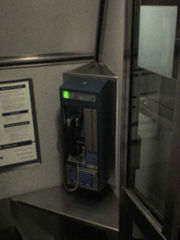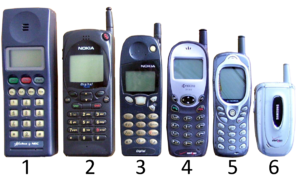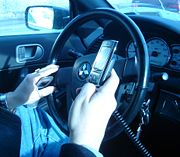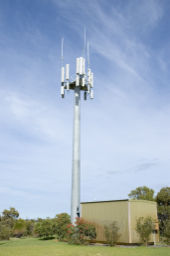Mobile phone
2008/9 Schools Wikipedia Selection. Related subjects: Engineering
The mobile phone or mobile, also called a cellular phone, or cell phone is a long-range, portable electronic device used for mobile communication that uses a network of specialized base stations known as cell sites. In addition to the standard voice function of a telephone, current mobile phones can support many additional services such as SMS for text messaging, email, packet switching for access to the Internet, and MMS for sending and receiving photos and video. Most current mobile phones connect to a cellular network of base stations ( cell sites), which is in turn interconnected to the public switched telephone network ( PSTN) (the exception is satellite phones).
| Mobile communication standards |
| GSM / UMTS ( 3GPP) Family |
GSM ( 2G)
|
UMTS ( 3G)
|
UMTS Rev. 8 ( Pre-4G)
|
|
|
| cdmaOne / CDMA2000 ( 3GPP2) Family |
| cdmaOne ( 2G) |
CDMA2000 ( 3G)
|
| UMB ( Pre-4G) |
|
|
| AMPS Family |
AMPS ( 1G)
|
| D-AMPS ( 2G) |
|
|
| Other Technologies |
0G
|
1G
|
2G
|
Pre-4G
|
|
|
Channel Access Methods
|
|
|
Frequency bands
|
History
There is one U.S. patent, Patent Number 887357 for a wireless telephone, issued 1908 to Nathan B. Stubblefield of Murray, Kentucky. He applied this to "cave radio" telephones and not directly to cellular telephony as the term is currently understood. However, the introduction of cells for mobile phone base stations, invented in 1947 by Bell Labs engineers at AT&T, was further developed by Bell Labs during the 1960s. Radiophones have a long and varied history going back to Reginald Fessenden's invention and shore-to-ship demonstration of radio telephony, through the Second World War with military use of radio telephony links and civil services in the 1950s, while hand-held cellular radio devices have been available since 1973. Due to their low establishment costs and rapid deployment, mobile phone networks have since spread rapidly throughout the world, outstripping the growth of fixed telephony.
In 1945, the zero generation ( 0G) of mobile telephones was introduced. 0G mobile telephones, such as Mobile Telephone Service, were not officially categorized as mobile phones, since they did not support the automatic change of channel frequency during calls, which allows the user to move from one cell (the base station coverage area) to another cell, a feature called " handover".
In 1984, Bell Labs invented such a "call handoff" feature, which allowed mobile-phone users to travel through several cells during the same conversation. Motorola is widely considered to be the inventor of the first practical mobile phone for handheld use in a non-vehicle setting. Using a modern, if somewhat heavy portable handset, Motorola manager Martin Cooper made the first call on a handheld mobile phone on April 3, 1973.
The first commercial cellular network was launched in Japan by NTT in 1979. Fully automatic cellular networks were first introduced in the early to mid 1980s (the 1G generation) with the Nordic Mobile Telephone (NMT) system in 1981. This was followed by a boom in mobile telephone usage, particularly in Northern Europe.
The first "modern" network technology on digital 2G (second generation) cellular technology was launched by Radiolinja (now part of Elisa Group) in 1991 in Finland on the GSM standard which also marked the introduction of competition in mobile telecoms when Radiolinja challenged incumbent Telecom Finland (now part of TeliaSonera) who ran a 1G NMT network. A decade later, the first commercial launch of 3G (Third Generation) was again in Japan by NTT DoCoMo on the WCDMA standard. Until the early 1990s, most mobile phones were too large to be carried in a jacket pocket, so they were typically installed in vehicles as car phones. With the miniaturization of digital components, mobile phones have become increasingly portable over the years.
Today, video and TV services are driving forward third generation (3G) deployment. And in the future, low cost, high speed data will drive forward the fourth generation (4G) as short-range communication emerges. Service and application ubiquity, with a high degree of personalization and synchronization between various user appliances,will be another driver. At the same time, it is probable that the radio access network will evolve from a centralized architecture to a distributed one.
Manufacturers
Nokia Corporation is currently the world's largest manufacturer of mobile telephones, with a global device market share of approximately 36% in Q1 of 2007. Other mobile phone manufacturers include Apple Inc., Audiovox (now UTStarcom), Benefon, BenQ-Siemens, High Tech Computer Corporation (HTC), Fujitsu, Kyocera, LG Mobile, Mitsubishi, Motorola, NEC, Neonode, Panasonic (Matsushita Electric), Pantech Curitel, Philips, Research In Motion, Sagem, Samsung, Sanyo, Sharp, Siemens, Sierra Wireless, SK Teletech, Sonim Technologies, Sony Ericsson, T&A Alcatel, and Toshiba. There are also specialist communication systems related to (but distinct from) mobile phones.
The mobile phone manufacturers can be grouped into two. The top five are available in practically all countries and comprise about 75% of all phones sold. A second tier of small manufacturers exists with phones mostly sold only in specific regions or for niche markets. The top five in order of market share are Nokia, Samsung, Motorola, SonyEricsson and LG.
Subscriptions

Several countries, including the UK, now have more mobile phones than people. There are over five hundred million active mobile phone accounts in China, as of 2007. Luxembourg has the highest mobile phone penetration rate in the world, at 164% in December 2001. In Hong Kong the penetration rate reached 139.8% of the population in July 2007. The total number of mobile phone subscribers in the world was estimated at 2.14 billion in 2005. The subscriber count reached 2.7 billion by end of 2006 according to Informa, and 3.3 billion by November, 2007, thus reaching an equivalent of over half the planet's population. Around 80% of the world's population enjoys mobile phone coverage as of 2006. This figure is expected to increase to 90% by the year 2010.
At present, Africa has the largest growth rate of cellular subscribers in the world, its markets expanding nearly twice as fast as Asian markets. The availability of prepaid or 'pay-as-you-go' services, where the subscriber is not committed to a long term contract, has helped fuel this growth in Africa as well as in other continents.
On a numerical basis, India is the largest growth market, adding about 6 million cell phones every month. With 256.55 million cell phones, market penetration in the country is still low at 22.52%. India expects to reach 500 million subscribers by end of 2010.
There are three major technical standards for the current generation of mobile phones and networks, and two major standards for the next generation 3G phones and networks. All European, African and many Asian countries have adopted a single system, GSM, which is the only technology available on all continents and in most countries and covers over 74% of all subscribers on mobile networks. In many countries, such as the United States, Australia, Brazil, India, Japan, and South Korea GSM co-exists with other internationally adopted standards such as CDMA and TDMA, as well as national standards such as iDEN in the USA and PDC in Japan. Over the past five years several dozen mobile operators (carriers) have abandoned networks on TDMA and CDMA technologies, switching over to GSM.
With third generation (3G) networks, which are also known as IMT-2000 networks, about three out of four networks are on the W-CDMA (also known as UMTS) standard, usually seen as the natural evolution path for GSM and TDMA networks. One in four 3G networks is on the CDMA2000 1x EV-DO technology. Some analysts count a previous stage in CDMA evolution, CDMA2000 1x RTT, as a 3G technology whereas most standardization experts count only CDMA2000 1x EV-DO as a true 3G technology. Because of this difference in interpreting what is 3G, there is a wide variety in subscriber counts. As of June 2007, on the narrow definition there are 200 million subscribers on 3G networks. By using the more broad definition, the total subscriber count of 3G phone users is 475 million.
While some systems of payment are 'pay-as-you-go' where conversation time is purchased and added to a phone unit via an Internet account or in shops or ATMs, other systems are more traditional ones where bills are paid by regular intervals. Pay as you go (also known as "pre-pay") accounts were invented simultaneously in Portugal and Italy and today form more than half of all mobile phone subscriptions. USA, Canada, Japan and Finland are among the rare countries left where most phones are still contract-based.
Culture and customs
In less than twenty years, the mobile telephone has gone from being rare, expensive equipment of the business elite to a pervasive, low-cost personal item. In many countries, mobile telephones outnumber land-line telephones; in the U.S., 50 percent of children have mobile telephones. In many young adults' households it has supplanted the land-line telephone. The mobile phone is banned in some countries, such as North Korea.
Given the high levels of societal mobile telephone service penetration, it is a key means for people to communicate with each other. The SMS feature spawned the " texting" sub-culture. In December 1993, the first person-to-person SMS text message was transmitted in Finland. Currently, texting is the most widely-used data service; 1.8 billion users generated $80 billion of revenue in 2006 (source ITU).
Many telephones offer Instant Messenger services for simple, easy texting. Mobile phones have Internet service (e.g. NTT DoCoMo's i-mode), offering text messaging via e-mail in Japan, South Korea, China, and India. In Europe, 30–40 per cent of internet access is via mobile telephone. Most mobile internet access is much different from computer access, featuring alerts, weather data, e-mail, search engines, instant messages, and game and music downloading; most mobile internet access is hurried and short.
The mobile telephone can be a fashion totem custom-decorated to reflect the owner's personality. This aspect of the mobile telephony business is, in itself, an industry, e.g. ringtone sales exceeded $5 billion in 2006.
Etiquette
Mobile telephone use in etiquette is an important matter of social discourtesy, phones ringing during funerals, weddings, in toilets, cinemas, and plays. Users often speak loudly, leading to book shops, libraries, bathrooms, cinemas, doctors' offices, and places of worship prohibiting their uses, and, in some places, the installation of signal-jamming equipment to prevent their use (though in many countries, including the U.S., such equipment is currently illegal). Some new buildings, such as auditoriums, have installed wire mesh in the walls (making it a Faraday cage), which prevents signal penetration without violating signal jamming laws.
Trains, particularly those involving long-distance services, often offer a "quiet carriage" where phone use is prohibited, much like the designated non-smoking carriage in the past. However many users tend to ignore this as it is rarely enforced, especially if the other carriages are crowded and they have no choice but to go in the "quiet carriage". Mobile phone use on aircraft is also prohibited and many airlines claim in their in-plane announcements that this prohibition is due to possible interference with aircraft radio communications. Shut-off mobile phones do not interfere with aircraft avionics; the concern is partially based on the crash of Crossair Flight 498.
As of 2007, several airlines are experimenting with base station and antenna systems installed to the aeroplane, allowing low power, short-range connection of any phones aboard to remain connected to the aircraft's base station. Thus, they would not attempt connection to the ground base stations as during take off and landing. Simultaneously, airlines may offer phone services to their travelling passengers either as full voice and data services, or initially only as SMS text messaging and similar services. Qantas, the Australian airline, is the first airline to run a test aeroplane in this configuration in the autumn of 2007. Emirates has announced plans to allow limited mobile phone usage on some flights.
In any case, there are inconsistencies between practices allowed by different airlines and even on the same airline in different countries. For example, Northwest Airlines may allow the use of mobile phones immediately after landing on a domestic flight within the US, whereas they may state "not until the doors are open" on an international flight arriving in the Netherlands. In April 2007 the US Federal Communications Commission officially grounded the idea of allowing passengers to use phones during a flight.
In a similar vein, signs are put up in many countries, such as Canada, the U.K. and the U.S., at petrol stations prohibiting the use of mobile phones, due to possible safety issues. Most schools in the United States have prohibited mobile phones in the classroom, due to the large number of class disruptions that result from their use, the potential for cheating via text messaging, and the possibility of photographing someone without consent. In the UK, possession of a mobile phone in an examination can result in immediate disqualification from that subject or from all that student's subjects.
A working group, made up of Finnish telephone companies, public transport operators and communications authorities, have launched a campaign to remind mobile phone users of courtesy, especially when using mass transit – what to talk about on the phone, and how to. In particular, the campaign wants to impact loud mobile phone usage as well as calls regarding sensitive matters.
Many US cities with subway transit systems underground are studying or have implemented cell phone reception in their underground tunnels for their riders. Boston, Massachusetts has investigated such usage in their tunnels, although there is a question of usage etiquette and also how to fairly award contracts to carriers.
The issue of mobile communication and etiquette has also become an issue of academic interest. The rapid adoption of the device has resulted in the intrusion of telephony into situations where this was previously not known. This has exposed the implicit rules of courtesy and opened them to reevaluation. http://www.richardling.com/papers/1997_One_can_talk_about_common_manners.pdf
Use in disaster response
The Finnish government decided in 2005 that the fastest way to warn citizens of disasters was the mobile phone network. In Japan, mobile phone companies provide immediate notification of earthquakes and other natural disasters to their customers free of charge. New Japanese phones offer Earthquake early warning alerts. Retrieved on 2008- 01-08. In the event of an emergency, disaster response crews can locate trapped or injured people using the signals from their mobile phones. An interactive menu accessible through the phone's Internet browser notifies the company if the user is safe or in distress. In Finland rescue services suggest hikers carry mobile phones in case of emergency even when deep in the forests beyond cellular coverage, as the radio signal of a cellphone attempting to connect to a base station can be detected by overflying rescue aircraft with special detection gear. Also, users in the United States can sign up through their provider for free text messages when an AMBER Alert goes out for a missing person in their area.
However, most mobile telephone networks operate close to capacity during normal times and spikes in call volumes caused by widespread emergencies often overload the system just when it is needed the most. Examples reported in the media where this have occurred include the 2001 September 11 attacks, the Hawaiian earthquake, the 2003 Northeast blackouts, the 2005 London Tube bombings, Hurricane Katrina, and the 2007 Minnesota bridge collapse. Thus mobile phones are better for isolated emergencies such as vehicle accidents.
Use by drivers
Mobile-phone use while driving is common but controversial. While few jurisdictions have banned motorists from using mobile phones while driving outright, some have banned or restricted drivers from using hand-held mobile phones while exempting phones operated in a hands-free fashion. Using a hand-held mobile phone while driving is an impediment to vehicle operation that can increase the risk of road traffic accidents. However, some studies have found similarly elevated accident rates among drivers using hands-free phones, suggesting that the distraction of a telephone conversation itself is a significant safety problem. A study done by the Transport Research Laboratory found that mobile phone users were four times more likely to be in a collision, regardless of whether the call was hands-free or not. This problem does not apply to conversations with a passenger, as passengers can regulate the flow of conversation according to the perceived level of danger, and also provides a second pair of eyes to spot hazards.
Applications
Mobile news services are expanding with many organizations providing "on-demand" news services by SMS. Some also provide "instant" news pushed out by SMS. Mobile telephony also facilitates activism and public journalism being explored by Reuters and Yahoo and small independent news companies such as Jasmine News in Sri Lanka. Companies like Monster are starting to offer mobile services such as job search and career advice. Consumer applications are on the rise and include everything from information guides on local activities and events to mobile coupons and discount offers one can use to save money on purchases. Even tools for creating websites for mobile phones are increasingly becoming available, e.g. Mobilemo.
The total value of mobile data services exceeds the value of paid services on the internet, and was worth 31 billion dollars in 2006 (source Informa). The largest categories of mobile services are music, picture downloads, videogaming, adult entertainment, gambling, video/TV.
Power
Mobile phones generally obtain power from batteries which can be recharged from mains power, a USB port or a cigarette lighter socket in a car. Formerly, the most common form of cell phone batteries were nickel metal-hydride, as they have a low size and weight. Lithium-Ion batteries are sometimes used, as they are lighter and do not have the voltage depression that nickel metal-hydride batteries do. Many mobile phone manufacturers have now switched to using lithium-Polymer batteries as opposed to the older Lithium-Ion, the main advantages of this being even lower weight and the possibility to make the battery a shape other than strict cuboid. Cell phone manufacturers have been experimenting with alternate power sources, including solar cells.
Features
There are significant questions as to who first invented the camera phone, as numerous other people received patents filed in the early 1990s for the device, including David M. Britz of AT&T Research in March of 1994 and Phillipe Kahn, who claims to have first invented it in 1997. The camera phone now holds 85% of the mobile phone market. Mobile phones often have features beyond sending text messages and making voice calls, including Internet browsing, music ( MP3) playback, memo recording, personal organizer functions, e-mail, instant messaging, built-in cameras and camcorders, ringtones, games, radio, Push-to-Talk (PTT), infrared and Bluetooth connectivity, call registers, ability to watch streaming video or download video for later viewing, video calling and serve as a wireless modem for a PC, and soon will also serve as a console of sorts to online games and other high quality games (e.g. Final Fantasy Agito).
Tariff models
When cellular telecoms services were launched, phones and calls were very expensive and early mobile operators (carriers) decided to charge for all air time consumed by the mobile phone user. This resulted in the concept of charging callers for outbound calls and also for receiving calls. As mobile phone call charges diminished and phone adoption rates skyrocketed, more modern operators decided not to charge for incoming calls. Thus some markets have "Receiving Party Pays" models (also know as "Mobile Party Pays"), in which both outbound and received calls are charged, and other markets have "Calling Party Pays" models, by which only making calls produces costs, and receiving calls is free. An exception to this are international roaming tariffs, by which receiving calls are normally also charged.
The European market adopted a "Calling Party Pays" model throughout the GSM environment and soon various other GSM markets also started to emulate this model. As Receiving Party Pays systems have the undesired effect of phone owners keeping their phones turned off to avoid receiving unwanted calls, the total voice usage rates (and profits) in Calling Party Pays countries outperform those in Receiving Party Pays countries. Consequently, most countries previously with Receiving Party Pays models have either abandoned them or employed alternative marketing methods, such as massive voice call buckets, to avoid the problem of phone users keeping phones turned off.
In most countries today, including Syria, European Union nations, United Arab Emirates, Kazakhstan, Turkey, New Zealand, Korea, Japan, Pakistan, Argentina, Australia, Brazil, Chile, Colombia, India, Maldives, Malaysia, Peru, South Africa, Israel, Lebanon, Egypt and Jordan the person receiving a mobile phone call pays nothing. However, in Hong Kong, Canada, and the United States, one can be charged per minute. In the United States, a few carriers are beginning to offer unlimited received phone calls. For the Chinese mainland, it was reported that both of its two operators will adopt the caller-pays approach as early as January 2007.
Developing countries
In some developing countries with little telephone infrastructure, the mobile telephone is the telephony giving poor people access to medical and legal services. Cell phone use in developing countries has quadrupled in the last decade. The rise of cell phone technology in developing countries is often cited as an example of the leapfrog effect. In many remote regions in the third world went literally from having no telecommunications infrastructure to having satellite based communications systems.
Forensics and evidence
Law enforcement globally rely heavily upon mobile telephone evidence, to the extent that in the EU the "communications of every mobile telephone user are recorded". The concerns over terrorism and terrorist use of technology prompted an inquiry by the British House of Commons Home Affairs Select Committee into the use of evidence from mobile telephone devices, prompting leading mobile telephone forensic specialists to identify forensic techniques available in this area. NIST have published guidelines and procedures for the preservation, acquisition, examination, analysis, and reporting of digital information present on cell phones can be found under the NIST Publication SP800-101.
An example of criminal investigations using mobile phones is the initial location and ultimate identification of the terrorists of the 2004 Madrid train bombings. In the attacks, mobile phones had been used to detonate the bombs. However, one of the bombs failed to detonate, and the SIM card in the corresponding mobile phone gave the first serious lead about the terrorists to investigators. By tracking the whereabouts of the SIM card and correlating other mobile phones that had been registered in those areas, police were able to locate the terrorists.
Human health impacts
Since the introduction of mobile phones, concerns have been raised about the potential health impacts from regular use. As mobile phone penetrations grew past fixed landline penetration levels in 1998 in Finland and from 1999 in Sweden, Denmark and Norway, the Scandinavian health authorities have run continuous long term studies of effects of mobile phone radiation effects to humans, and in particular children. Numerous studies have reported and most studies consistently report no significant relationship between mobile phone use and health. Studies from the Institute of Cancer Research, National Cancer Institute and researchers at the Danish Institute of Cancer Epidemiology in Copenhagen for example showed no link between mobile phone use and cancer. The Danish study only covered analog mobile phone usage up through 1995, and subjects who started mobile phone usage after 1995 were counted as non-users in the study. The health concerns have grown as mobile phone penetration rates throughout Europe reached 80%–90% levels earlier in this decade and prolonged exposure studies have been carried out in almost all European countries again most reporting no effect, and the most alarming studies only reporting a possible effect. However, a study by the International Agency for Research on Cancer of 4,500 users found a borderline statistically significant link between tumor frequency on the same side of the head as the cell phone was used on and cell phone usage.
One study that reviewed the link between cellphones and sperm quality found that heavy mobile phone users (>4 hours per day) had significantly less viable sperm (WHO morphology score was less than half of the lower time cell phone users). A prospective study of 13 normal men found that significantly increasing their cell phone use (>6 hours each day for 5 days) caused a marked short-term reduction of sperm quality.
This is considered to be a thermal effect, since the testes are vulnerable to heating by RF energy because of poor circulation and heat is known to have adverse effects on male fertility. The eyes are the other part of the body known to be poor at dissipating heat. Experiments have shown that short duration exposure to very high levels of RF radiation can cause cataracts in rabbits. The non-thermal effects of RF radiation are an area of active study.
Environmental impacts
Impact of active cell phone usage
Like all high structures, cellular antenna masts pose a hazard to low flying aircraft. Towers over a certain height or towers that are close to airports or heliports are normally required to have warning lights. There have been reports that warning lights on cellular masts, TV-towers and other high structures can attract and confuse birds. US authorities estimate that millions of birds are killed near communication towers in the country each year.
An example of the way mobile phones and mobile networks have sometimes been perceived as a threat is the widely reported and later discredited claim that mobile phone masts are associated with the Colony Collapse Disorder (CCD) which has reduced bee hive numbers by up to 75% in many areas, especially near cities in the US. The Independent newspaper cited a scientific study claiming it provided evidence for the theory that mobile phone masts are a major cause in the collapse of bee populations, with controlled experiments demonstrating a rapid and catastrophic effect on individual hives near masts. Mobile phones were in fact not covered in the study, and the original researchers have since emphatically disavowed any connection between their research, mobile phones, and CCD, specifically indicating that the Independent article had misinterpreted their results and created "a horror story". While the initial claim of damage to bees was widely reported, the corrections to the story were almost non-existent in the media.
Impact of disposed phones
There are more than 500 million used mobile phones in the US sitting on shelves or in landfills, and another 125 million will be added to the shelves or landfills this year alone. The problem is growing at a rate of more than two million phones per week, putting tons of toxic waste into landfills daily. Several sites including United States top ranked TradeMyCell.com, ReCellular, and MyGreenElectronics offer to remedy to this situation by buying back and recycling cell phones from users.
Technology
Mobile phones and the network they operate under vary significantly from provider to provider, and country to country. However, all of them communicate through electromagnetic radio waves with a cell site base station, the antennas of which are usually mounted on a tower, pole or building.
The phones have a low-power transceiver that transmits voice and data to the nearest cell sites, usually not more than 8 to 13 km (approximately 5 to 8 miles) away. When the mobile phone or data device is turned on, it registers with the mobile telephone exchange, or switch, with its unique identifiers, and will then be alerted by the mobile switch when there is an incoming telephone call. The handset constantly listens for the strongest signal being received from the surrounding base stations. As the user moves around the network, the mobile device will " handoff" to various cell sites during calls, or while waiting (idle) between calls it will reselect cell sites.
Cell sites have relatively low-power (often only one or two watts) radio transmitters which broadcast their presence and relay communications between the mobile handsets and the switch. The switch in turn connects the call to another subscriber of the same wireless service provider or to the public telephone network, which includes the networks of other wireless carriers. Many of these sites are camouflaged to blend with existing environments, particularly in scenic areas.
The dialogue between the handset and the cell site is a stream of digital data that includes digitized audio (except for the first generation analog networks). The technology that achieves this depends on the system which the mobile phone operator has adopted. The technologies are grouped by generation. The first-generation systems started in 1979 with Japan, are all analog and include AMPS and NMT. Second-generation systems, started in 1991 in Finland, are all digital and include GSM, CDMA and TDMA. Third-generation networks, which are still being deployed, started with Japan in 2001, are all digital, and offer high-speed data access in addition to voice services and include W-CDMA (known also as UMTS), and CDMA2000 EV-DO. China will launch a third 3G technlogy on the TD-SCDMA standard. Each network operator has a unique radio frequency band.
Books about mobile communication
Since 2002, many books have been written on the social impact of mobile phones:
- Agar, Jon, Constant Touch: A Global History of the Mobile Phone, 2004 ISBN 1840465417
- Ahonen, Tomi, m-Profits: Making Money with 3G Services, 2002, ISBN 0-470-84775-1
- Ahonen, Kasper and Melkko, 3G Marketing 2004, ISBN 0-470-85100-7
- Glotz, Peter & Bertsch, Stefan, eds. Thumb Culture: The Meaning of Mobile Phones for Society, 2005
- Katz, James E. & Aakhus, Mark, eds. Perpetual Contact: Mobile Communication, Private Talk, Public Performance, 2002
- Kavoori, Anandam & Arceneaux, Noah, eds. The Cell Phone Reader: Essays in Social Transformation, 2006
- Levinson, Paul, Cellphone: The Story of the World's Most Mobile Medium, and How It Has Transformed Everything!, 2004 ISBN 1-4039-6041-0
- Ling, Rich, The Mobile Connection: the Cell Phone's Impact on Society, 2004 ISBN 1558609369
- Ling, Rich and Pedersen, Per, eds. Mobile Communications: Re-negotiation of the Social Sphere, 2005 ISBN 1852339314
- Home page of Rich Ling
- Nyíri, Kristóf, ed. Mobile Communication: Essays on Cognition and Community, 2003
- Nyíri, Kristóf, ed. Mobile Learning: Essays on Philosophy, Psychology and Education, 2003
- Nyíri, Kristóf, ed. Mobile Democracy: Essays on Society, Self and Politics, 2003
- Nyíri, Kristóf, ed. A Sense of Place: The Global and the Local in Mobile Communication, 2005
- Nyíri, Kristóf, ed. Mobile Understanding: The Epistemology of Ubiquitous Communication, 2006
- Plant, Dr. Sadie, on the mobile – the effects of mobile telephones on social and individual life, 2001
- Rheingold, Howard, Smart Mobs: The Next Social Revolution, 2002 ISBN 0738208612
Terminology
Related non-mobile-phone systems
- Cordless telephone (portable phone)
- Cordless phones are standard telephones with radio handsets. Unlike mobile phones, cordless phones use private base stations that are not shared between subscribers. The base station is connected to a land-line. Increasingly, with wireless local loop technologies, namely DECT, the distinction is blurred.
- Professional Mobile Radio
- Advanced professional mobile radio systems can be very similar to mobile phone systems. Notably, the IDEN standard has been used as both a private trunked radio system as well as the technology for several large public providers. Similar attempts have even been made to use TETRA, the European digital PMR standard, to implement public mobile networks.
- Radio phone
- This is a term which covers radios which could connect into the telephone network. These phones may not be mobile; for example, they may require a mains power supply. Also, they may require the assistance of a human operator to set up a PSTN phone call.
- Satellite phone
- This type of phone communicates directly with an artificial satellite which in turn relays calls to a base station or another satellite phone. A single satellite can provide coverage to a much greater area than terrestrial base stations. Satellite phones are often used in remote areas where no mobile phone coverage exists and at sea.





